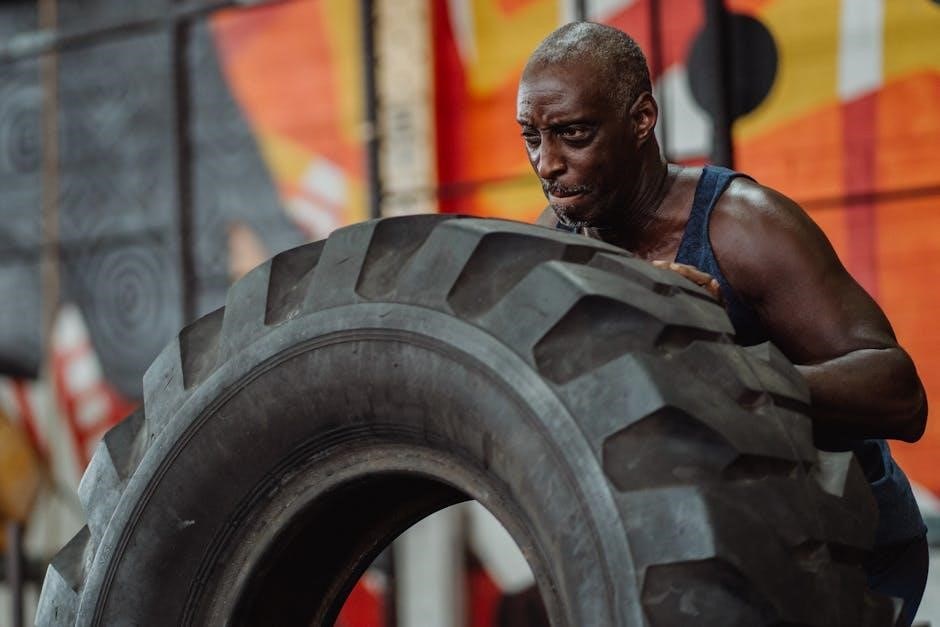Resistance band exercises are a fantastic entry point into fitness for beginners. They’re affordable‚ portable‚ and versatile‚ offering a full-body workout option. Resistance bands provide adaptable resistance‚ perfect for building strength and improving flexibility at your own pace.
What are Resistance Bands and Their Benefits?
Resistance bands are elastic strips used for strength training. They come in varying resistance levels‚ often indicated by color‚ catering to different fitness levels. The bands create tension‚ challenging your muscles throughout an exercise’s range of motion‚ promoting muscle growth and strength gains. Unlike weights‚ resistance bands offer variable resistance‚ meaning the tension increases as the band is stretched.
The benefits of resistance bands are numerous. They are lightweight and portable‚ making them ideal for home workouts or travel. Resistance bands are also cost-effective compared to gym memberships or bulky equipment. They are gentle on the joints‚ reducing the risk of injury‚ and suitable for all fitness levels‚ from beginners to advanced exercisers. Furthermore‚ they enhance flexibility and balance while improving muscle tone and strength. Utilizing resistance bands can provide a comprehensive and effective workout experience.
Getting Started with Resistance Bands
Embarking on your resistance band journey involves selecting the right band and understanding safety. Proper form prevents injury‚ ensuring a successful workout. Start slow‚ listen to your body‚ and enjoy.
Choosing the Right Resistance Band for Your Fitness Level
Selecting the appropriate resistance band is crucial for beginners. Bands come in varying resistance levels‚ typically indicated by color. Start with a lighter band if you’re new to exercise‚ allowing you to master form without excessive strain. As your strength improves‚ gradually increase the resistance.
Consider a set of bands with different resistance levels for versatility. This enables you to target different muscle groups with appropriate challenge. Always prioritize controlled movements over heavy resistance. If you can’t maintain proper form‚ the band is too strong. Focus on feeling the muscle working throughout the exercise.
Experiment to find the resistance that allows you to complete the recommended repetitions with good form. Remember‚ consistency and proper technique are key to achieving results and preventing injuries.
Essential Safety Tips Before Starting Your Workout
Prioritizing safety is paramount when starting a resistance band workout. Before each session‚ inspect your bands for any rips‚ tears‚ or signs of wear. Damaged bands can snap‚ causing injury. Always secure the band properly‚ ensuring it’s anchored firmly to prevent slippage.
Maintain a stable base and controlled movements throughout each exercise. Avoid jerking or using momentum‚ which can lead to strains. If you feel any sharp pain‚ stop immediately. Start with a proper warm-up to increase blood flow and prepare your muscles.
Focus on correct form to maximize effectiveness and minimize the risk of injury. If you’re unsure about proper technique‚ consult a fitness professional. Listen to your body and gradually increase the intensity and duration of your workouts. Always cool down and stretch after exercising to promote recovery and flexibility.

Beginner-Friendly Resistance Band Exercises
Embark on your fitness journey with these beginner-friendly resistance band exercises. These simple yet effective movements target major muscle groups‚ helping you build strength‚ improve flexibility‚ and boost overall fitness safely and efficiently.
Squats
Squats are a fundamental exercise‚ and using a resistance band enhances their effectiveness for beginners. To perform a resistance band squat‚ stand with your feet shoulder-width apart‚ placing the band securely under your feet. Grip the ends of the band with your hands‚ ensuring there’s enough tension.
Begin the exercise in a standing position and slowly lower your body as if sitting in a chair‚ keeping your back straight and your core engaged. Ensure your knees don’t extend past your toes. Maintain a controlled movement as you lower and rise back to the starting position.
Resistance band squats strengthen your legs‚ glutes‚ and core‚ promoting overall lower body strength and stability. Aim for 12-16 repetitions per set‚ focusing on proper form and controlled movements. As you gain strength‚ you can increase the resistance of the band to continue challenging your muscles.
Rows
Rows are an excellent exercise for targeting the back muscles‚ and resistance bands make them accessible for beginners. To perform a resistance band row‚ sit on the floor with your legs extended in front of you. Place the center of the resistance band around your feet‚ holding an end in each hand.
Maintain a straight back and engage your core. Pull the band towards your torso‚ keeping your elbows close to your body. Squeeze your shoulder blades together as you pull. Slowly return to the starting position‚ resisting the band’s pull.
Resistance band rows strengthen your back‚ shoulders‚ and biceps‚ improving posture and upper body strength. Aim for 12-16 repetitions per set‚ focusing on controlled movements and proper form. Adjust the band’s tension by wrapping it around your feet more or less to find a suitable resistance level.
Bicep Curls
Bicep curls are a classic exercise for building upper arm strength‚ and resistance bands offer a convenient way to perform them. Stand on the center of the resistance band with your feet shoulder-width apart‚ holding an end of the band in each hand‚ palms facing forward. Keep your elbows close to your sides throughout the exercise.
Slowly curl your hands up towards your shoulders‚ contracting your biceps. Focus on using your bicep muscles to lift the band‚ avoiding swinging or using momentum. Pause briefly at the top of the movement‚ squeezing your biceps.
Gradually lower your hands back to the starting position‚ resisting the band’s pull to control the descent. Resistance band bicep curls effectively target the biceps muscles‚ helping to improve arm strength and definition. Aim for 12-16 repetitions per set‚ adjusting the band’s tension by altering your stance to find the right level of resistance.

Full Body Resistance Band Workout for Beginners (PDF Availability)
Get ready for a comprehensive workout targeting every major muscle group. Access our free printable resistance band exercise chart PDF for easy guidance‚ perfect for achieving a full-body burn.
Accessing Free Printable Resistance Band Exercise Charts
Unlock a world of fitness possibilities with our readily available‚ free printable resistance band exercise charts. These charts are designed to guide beginners through effective routines‚ targeting all major muscle groups. Downloadable in PDF format‚ these charts offer a convenient way to structure your workouts‚ ensuring proper form and progression. Whether you’re at home or on the go‚ these printable resources provide accessible guidance for a full-body resistance band workout; Explore a variety of exercises‚ from squats and rows to bicep curls and more‚ all clearly illustrated for ease of understanding. Start your fitness journey today with these invaluable tools‚ empowering you to achieve your goals with confidence and clarity. These charts are perfect for those who prefer a visual guide and a structured approach to their exercise routine. With clear instructions and diagrams‚ you can confidently perform each exercise‚ maximizing your results and minimizing the risk of injury. Embrace the convenience and effectiveness of these free resources and elevate your resistance band workouts to new heights.

Creating a Consistent Resistance Band Workout Routine
Consistency is key! Establish a regular resistance band workout routine to see results. Start slowly‚ focus on proper form‚ and gradually increase intensity. A sustainable schedule will lead to long-term fitness success.
Frequency and Duration for Beginners
For beginners embarking on a resistance band journey‚ understanding the optimal frequency and duration is crucial for maximizing results while minimizing the risk of injury. Aim for 2-3 resistance band workouts per week‚ allowing for adequate rest and recovery between sessions. Each workout should last between 20-30 minutes‚ focusing on proper form and controlled movements rather than rushing through repetitions.
Start with one set of 12-16 repetitions for each exercise‚ gradually increasing to two or three sets as your strength improves. Listen to your body and don’t hesitate to take breaks when needed. Consistency is key‚ so find a schedule that fits your lifestyle and stick with it. Remember‚ even short‚ regular workouts can deliver significant benefits over time‚ helping you build strength‚ improve flexibility‚ and achieve your fitness goals with resistance bands.

Advanced Resistance Band Exercises
Once you’ve mastered the basics‚ explore advanced resistance band exercises to further challenge your muscles. These exercises involve complex movements and higher resistance levels‚ promoting continued strength and muscle growth with bands.
Progressing to More Challenging Exercises
Once you’ve consistently performed beginner resistance band exercises with proper form and have built a solid foundation‚ it’s time to progress to more challenging variations. This progression is crucial for continued muscle growth‚ strength gains‚ and overall fitness improvement. Start by gradually increasing the resistance level of your bands. If you’re using light bands‚ move up to medium or heavy resistance bands. Another way to increase the challenge is by increasing the number of repetitions or sets you perform. You can also reduce rest time between sets‚ which will increase the intensity of your workout.
Consider incorporating unilateral exercises‚ which involve working one side of your body at a time. These exercises can help improve balance and coordination‚ while also targeting specific muscle groups. Experiment with different angles and ranges of motion to target muscles from various perspectives. Remember to prioritize proper form and technique as you progress to more challenging exercises to avoid injuries. If you experience any pain‚ stop the exercise and consult with a fitness professional.

Be First to Comment